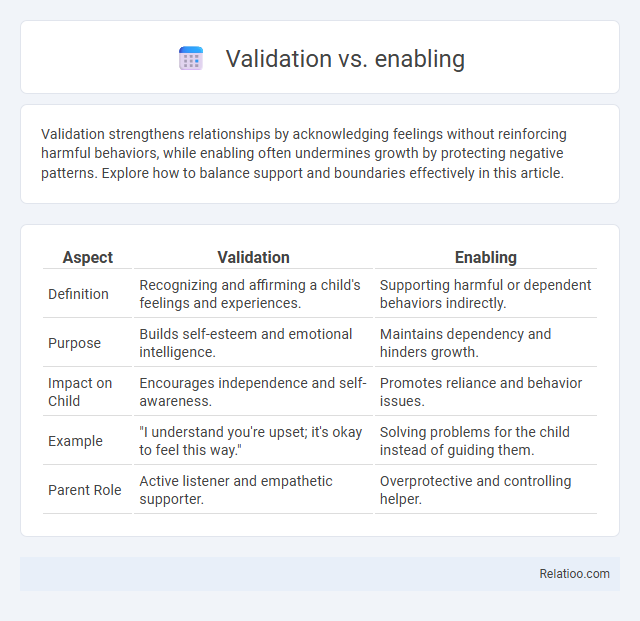Validation strengthens relationships by acknowledging feelings without reinforcing harmful behaviors, while enabling often undermines growth by protecting negative patterns. Explore how to balance support and boundaries effectively in this article.
Table of Comparison
| Aspect | Validation | Enabling |
|---|---|---|
| Definition | Recognizing and affirming a child's feelings and experiences. | Supporting harmful or dependent behaviors indirectly. |
| Purpose | Builds self-esteem and emotional intelligence. | Maintains dependency and hinders growth. |
| Impact on Child | Encourages independence and self-awareness. | Promotes reliance and behavior issues. |
| Example | "I understand you're upset; it's okay to feel this way." | Solving problems for the child instead of guiding them. |
| Parent Role | Active listener and empathetic supporter. | Overprotective and controlling helper. |
Understanding Validation and Enabling
Validation involves acknowledging and affirming someone's feelings or behaviors, fostering self-awareness and emotional growth, while enabling refers to unintentionally supporting harmful or dependent behaviors by shielding individuals from consequences. Understanding validation requires recognizing the difference between supportive acceptance and reinforcing negative patterns through enabling. Emphasizing healthy boundaries ensures validation promotes empowerment without perpetuating dysfunction or dependency.
Key Differences Between Validation and Enabling
Validation involves recognizing and affirming Your feelings or experiences without necessarily encouraging problematic behavior, while enabling allows harmful patterns to continue by making excuses or removing consequences. Validation seeking is the active pursuit of approval or acknowledgment from others, which differs from enabling that often stems from caretaking or avoidance of conflict. Understanding these distinctions helps in fostering healthy relationships where support does not perpetuate dysfunction.
Psychological Impact of Validation
Validation acknowledges and affirms Your emotions and experiences, fostering self-acceptance and emotional regulation. Enabling often unintentionally supports harmful behaviors by excusing consequences, which can hinder personal growth and accountability. Validation seeking, driven by a need for external approval, may weaken self-esteem and increase anxiety when affirmation is inconsistent or absent.
The Consequences of Enabling Behavior
Enabling behavior often leads to negative consequences such as perpetuating harmful habits and preventing personal accountability, which can stall growth and recovery. Unlike validation or validation seeking, which foster emotional support and self-understanding, enabling allows destructive patterns to continue unchecked. Your awareness of these differences is crucial for promoting healthier interactions and personal development.
Validation: Supporting Healthy Growth
Validation fosters healthy growth by acknowledging Your feelings and experiences as genuine, promoting self-worth and emotional resilience. It strengthens relationships through empathy and active listening, creating a supportive environment where personal development thrives. Unlike enabling or validation seeking, true validation empowers individuals to grow independently and confidently without reliance on external approval.
Enabling: Unintended Negative Outcomes
Enabling behavior often leads to unintended negative outcomes by fostering dependency and undermining accountability, which can prevent personal growth and problem-solving skills. When you enable someone, you may unintentionally reinforce harmful patterns by shielding them from the consequences of their actions. Understanding the distinction between enabling, validation, and validation seeking is crucial to promoting healthier relationships and empowering positive change.
Signs You’re Validating vs. Enabling
Signs you're validating behavior include acknowledging feelings and experiences without judgment, reinforcing positive actions, and offering empathy that supports self-growth. In contrast, enabling signs involve making excuses for harmful conduct, taking responsibility for another's problems, and protecting them from consequences, which can perpetuate dependency. Validation seeks to empower autonomy and emotional health, while enabling undermines accountability and fosters unhealthy patterns.
Strategies for Healthy Validation
Strategies for healthy validation emphasize recognizing internal values while appreciating external feedback, fostering authentic self-esteem rather than reliance on others' approval. Enabling behavior often undermines personal growth by perpetuating dependency, unlike validation seeking, which when balanced, encourages constructive dialogue and emotional clarity. Effective strategies include setting boundaries, practicing self-compassion, and differentiating between supportive feedback and codependent validation demands to maintain psychological well-being.
Break the Cycle: Moving Away from Enabling
Breaking the cycle of enabling involves shifting focus from validation seeking to self-empowerment, emphasizing personal responsibility and healthy boundaries. Enabling behaviors often perpetuate dependence and hinder growth by reinforcing validation seeking, which undermines genuine self-worth. Moving away from enabling requires recognizing enabling patterns, fostering accountability, and promoting validation from within rather than relying on external approval.
Balancing Empathy With Accountability
Balancing empathy with accountability requires understanding the distinctions between validation, enabling, and validation seeking. Validation acknowledges and affirms Your emotions without excusing negative behavior, while enabling involves excusing actions that undermine personal growth or responsibility. Validation seeking indicates a reliance on external approval, which can hinder authentic self-regulation and accountability development.

Infographic: validation vs enabling
 relatioo.com
relatioo.com